NCERT Solutions for Class 9 Science Chapter 11 Sound provides detailed answers for all in-text and exercise Questions. These solutions contain an in-depth explanation of each topic involved in the chapter. Students studying in class 9 can access these solutions for free in PDF format.
All these solutions are prepared by expert teachers and updated for the current academic session. NCERT Solutions for Class 9 Science Chapter 11 Sound help students to understand the fundamental concepts given in class 9 Science textbook. We have prepared the answers to all the questions in an easy and well-structured manner. It helps students to grasp the chapter easily.
Class 9 Science Sound Intext Questions (Solved)
Page No: 129
Question 1: How does the sound produced by a vibrating object in a medium reach your ear?
Answer: When a body vibrates the air in its neighbourhood is alternately compressed and rarefied. The compressed air has a higher pressure than surrounding air. It, therefore, pushes the air particles near it causing compression to move forward. A rarefaction or low pressure is created at the original place. These compressions and rarefaction cause particles in the air to vibrate about their mean position. The energy is carried forward in these vibrations. This is how sound travels.
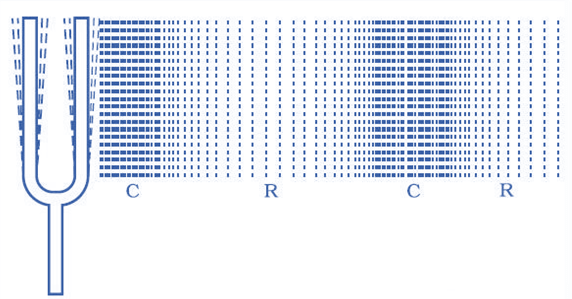
Question 2: Explain how sound is produced by your school bell?
Answer: When the gong strikes the bell, vibrations are produced in the bell which are transmitted through the air to our ears. These vibrations produce a sensation of sound in our ears.
Question 3: Why are sound waves called mechanical waves?
Answer: Sound waves are called mechanical waves because they need a material medium to travel.
Question 4: Suppose you and your friend are on the moon. Will you be able to hear any sound produced by your friend?
Answer: On the moon, sound cannot travel as there is no atmosphere. Sound cannot travel in vacuum so we will not be able to hear any sound.
Page no.132
Question 1: Which waves property determines
(a) loudness (b) pitch?
Answer: (a) Loudness is determined by the amplitude of the sound. Greater the amplitude more will be the loudness.
(b) Pitch is determined by frequency. Higher is the frequency, greater will be the pitch.
Question 2: Guess which sound has a higher pitch: guitar or car horn?
Answer: Guitar
Page no. 132
Question 1: What are wavelength, frequency, time period and amplitude of a sound wave?
Answer: Wavelength: The distances between two consecutive compressions or rarefaction of a wave. Its S.I unit is meter.
Frequency: One compression and one rarefaction constitutes one vibration. The number of vibration in a second is called frequency. Its unit is Hertz.
Amplitude: When waves are produced, the particles vibrate about their mean position. The maximum displacement from its mean position of a particle is called its amplitude. It is measured in meters.
Time period: The time taken by the wave to complete one oscillation i.e., the time between two consecutive compressions or rarefactions is called time period.
Question 2: How are the wavelength and frequency of a sound wave related to its speed?
Answer:
Speed = Wavelength x frequency
⇒ V = λ × ν
Question 3: Calculate the wavelength of a sound wave whose frequency is 220 Hz and speed is 440 m/s in a given medium.
Answer: Given, f = 220 Hz, V = 440 m/s

Question 4: A person is listening to a tone of 500 Hz sitting at a distance of 450 m from the source of the sound. What is the time interval between successive compressions from the source?
Answer: ν = 500 Hz.

Page no. 133
Question 1: Distinguish between loudness and intensity of sound?
Answer: Loudness and intensity of sound differ in the following ways:
Loudness:
- It’s a subjective measure, meaning it depends on the listener’s perception.
- Loudness is how we perceive the strength or volume of a sound.
- It can be influenced by factors such as the listener’s hearing sensitivity and the sound’s frequency.
Intensity of Sound:
- It’s an objective measure, quantifiable and measured in decibels (dB).
- Intensity refers to the amount of sound energy that passes through a unit area per second.
- It depends on the sound wave’s amplitude and the distance from the sound source.
In essence, intensity is a physical property of sound, while loudness is how we perceive that sound.
Page no. 133
Question 1: In which of the three media, air, water or iron, does sound travel the fastest at a particular temperature?
Answer: Sound travels faster in iron and slower in air.
Page no. 134
Question 1: An echo returned in 3 s. What is the distance of the reflecting surface from the source, given that the speed of sound is 342 ms−1 ?
Answer: Given, Time for echo = 3 s
v = 342 m/s
Therefore distance: d = v × t
= 342 × 3 m
= 513 m.
Page no. 135
Question 1: Why are the ceilings of concert halls curved?
Answer: The ceilings of concert halls are curved so that after reflections from the surface, sound can reach each and every part of the hall.
Page no. 136
Question 1: What is the audible range of the average human ear?
Answer: Audible range 20 Hz − 20,000 Hz
Question 2: What is the range of frequencies associated with (a) Infra sound? (b) Ultrasound?
Answer:
(a) Infra-sound is less than 20 Hz
(b) Ultra-sound is greater than 20, 000 Hz.
CBSE Class 9 Science Sound Exercise Questions and Answers
Question 1: What is sound and how is it produced?
Answer: Sound is a form of energy and it is produced due to vibrations of different types of object.
For example: A vibrating tuning fork, a bell, wires in a sitar and a guitar etc.
Question 2: Describe with the help of a diagram, how compressions and rarefactions are produced in air near a source of sound.
Answer: If we blow a horn, speak, or produce sound by an object in the air we are pushing the air molecules. These molecules, in turn, push the adjacent molecules which impart their energy to the next ones. After losing energy in the interaction, the molecule is back to its original (mean position. This results in the formation of compressions and rarefactions.
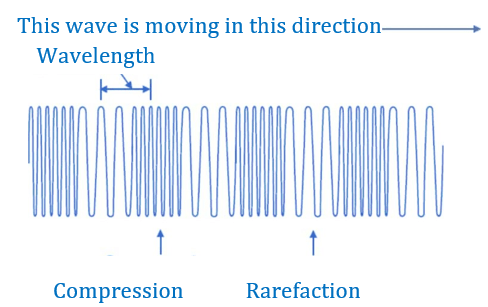
Question 3: Why sound wave is called a longitudinal wave?
Answer: A sound wave is called a longitudinal wave because it travels in the form of compressions and rarefactions in the medium, where the particles of the medium vibrate in a direction which is parallel to the direction of propagation of the sound wave.
Question 4: Which characteristic of the sound helps you to identify your friend by his voice while sitting with others in a dark room?
Answer: The timbre of sound is that characteristic which enables us to distinguish one sound from the other even when these are of the same pitch and loudness. Each person has its own timbre of sound and this characteristic helps us to identify a person from others even without looking at him (i.e., in a dark room).
Question 5: Flash and thunder are produced simultaneously. But thunder is heard a few seconds after the flash is seen, why?
Answer: The flash of light is seen earlier than the thunder of sound even though both are produced simultaneously because the speed of light (c) is greater than the speed of sound (v) by 106 as

Question 6: A person has a hearing range from 20 Hz to 20 kHz. What are the typical wavelengths of sound waves in air corresponding to these two frequencies? Take the speed of sound in air as 344 m-1.
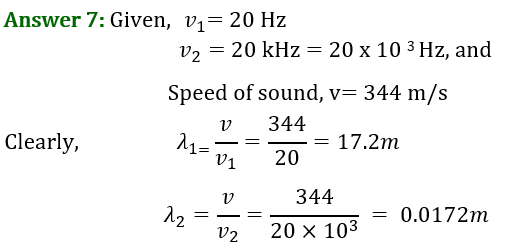
Question 7: Two children are at opposite ends of an aluminium rod. One strikes the end of the rod with a stone. Find the ratio of times taken by the sound wave in air and in aluminium to reach the second child.
Answer: Speed of sound in air = 346 m/s and
Speed of sound in aluminium = 6420 m/s
Since the time taken by sound to travel a given distance in a medium is inversely proportional to its speed in that medium, therefore

Question 8: The frequency of a source of sound is 100 Hz. How many times does it vibrate in a minute?
Answer: Since the frequency of the source of sound is 100 Hz,
Number of vibrations of the source in 1 second = 100
Number of vibrations of the source in 1 minute (i.e., 60 seconds)
= 100 ×6
= 6000
Question 9: Does sound follow the same laws of reflection as light does? Explain.
Answer: Yes, sound follows the same laws of reflection as light does.
The laws of reflection of sound are as follows:
- The incident sound wave, the reflected sound wave, and the normal at the point of incident all lie in the plane.
- The angle of incidence of sound wave and angle of reflection of sound wave to the normal are equal.
Question 10: When a sound is reflected from a distant object, an echo is produced. Let the distance between the reflecting surface and the source of sound production remains the same. Do you hear echo sound on a hotter day?
Answer: In any medium as we increase the temperature the speed of sound increases. For example, the speed of sound in air is 331 m/s at 0°c and 344 m/s at 22°c. So, on a hotter day, we cannot hear the echo between the same distances.
Question 11: Give two practical applications of reflection of sound waves.
Answer: The practical applications of sound are as follows:
- Megaphones or loudhailers are based on multiple reflections of sound.
- Stethoscope is a medical instrument used for listening to sounds produced within the body is also based on multiple reflection of sound.
Question 12: A stone is dropped from the top of a tower 500 m high into a pond of water at the base of the tower. When is the splash heard at the top? Given, g = 10 ms-2 and speed of sound = 340 m/s.
Answer: During the downward motion of the stone
Initial velocity u = 0 m/s
Height h = 500 m
Acceleration g = 10ms-2
Now we have
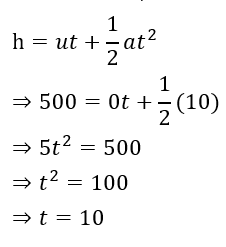
So, stone takes 10 seconds to pond from the top of the tower. Now a sound of splash is produced.
Now the time taken by the sound from the base of the tower to the top of the tower is given by
Time = distance ÷ speed
= 500 ÷ 340
= 1.47 seconds
So, the total time taken = 10 seconds + 1.47 seconds = 11.47 seconds
Question 13: A sound wave travels at a speed of 339 ms-1 . If its wavelength is 1.5 cm, what is the frequency of the wave? Will it be audible?
Answer: We know that, Frequency = Speed/Wavelength
Here, Speed = 339 m s-1
Wavelength = 1.5 cm = 0.015 m
Therefore, Frequency = 339/0.013 = 22600 Hz
It is not audible (as the audible frequency is 20 Hz to 20000 Hz).
Question 14: What is reverberation? How can it be reduced?
Answer: A sound created in a big hall will persist by repeated reflection from the walls until it is reduced to a value where it is no longer audible. The repeated reflection that results in this persistence of sound is called reverberation.
To reduce reverberation, the roof and walls of the auditorium are generally covered with sound-absorbent materials like compressed fibreboard, rough plaster or draperies. The seat materials are also selected based on their sound absorbing properties.
Question 15: What is loudness of sound? What factors does it depend on?
Answer: Loudness of sound is how loud or soft we perceive a sound to be. It’s a subjective measure and can vary from person to person.
The loudness (or softness) of a sound is determined by its amplitude. If the amplitude is higher, it is a louder sound. It depends upon the force with which an object is made to vibrate.
Question 16: How is ultrasound used for cleaning?
Answer: To clean any objects, it is placed in a cleaning solution and ultrasonic waves are sent into the solution. Due to the high frequency, the particles of dust, grease and dirt get detached and drop out. The objects thus get thoroughly cleaned.
Question 17: Explain how defects in a metal block can be detected using ultrasound.
Answer: Ultrasounds can be used to detect the defect in metal blocks. The cracks or holes inside the metal blocks, which are invisible from outside reduces the strength of the structure. Ultrasonic waves are allowed to pass through the metal block and detectors are used to detect the transmitted waves. If there is even a small defect, the ultrasound gets reflected back indicating the presence of the flaw or defect, as shown in the following figure.
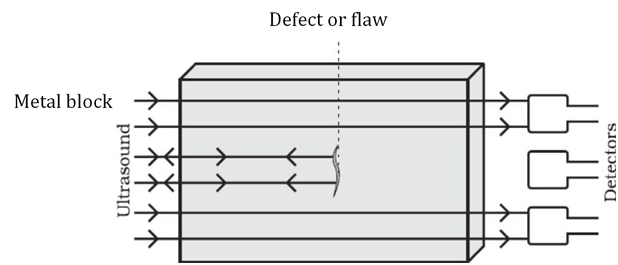
Similarly, the eardrum moves outward when a rarefaction reaches it. In this way the eardrum vibrates. The vibrations are amplified several times by three bones (the hammer, anvil and stirrup) in the middle ear. The middle ear transmits the amplified pressure variations received from the sound wave to the inner ear. In the inner ear, the pressure variations are turned into electrical signals by the cochlea. These electrical signals are sent to the brain via the auditory nerve, and the brain interprets them as sound